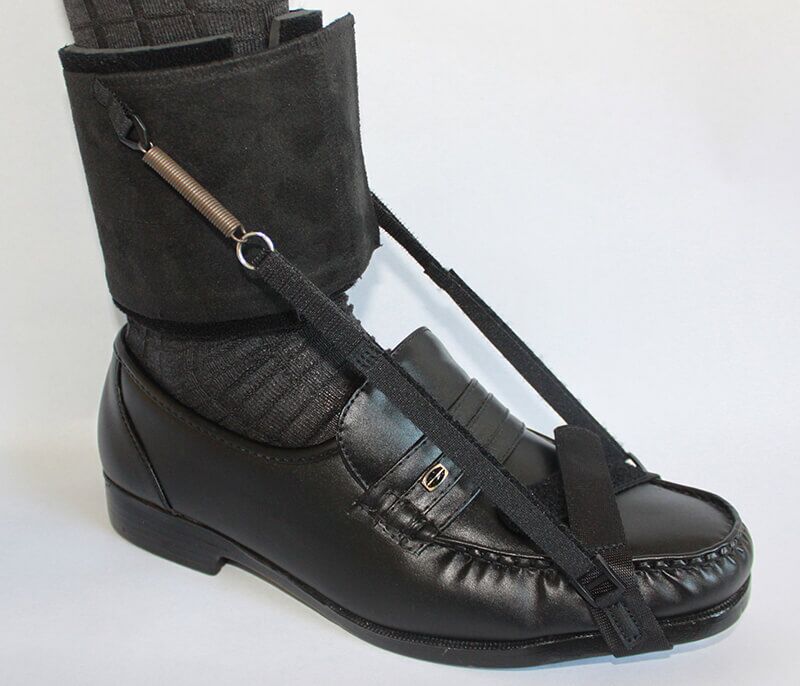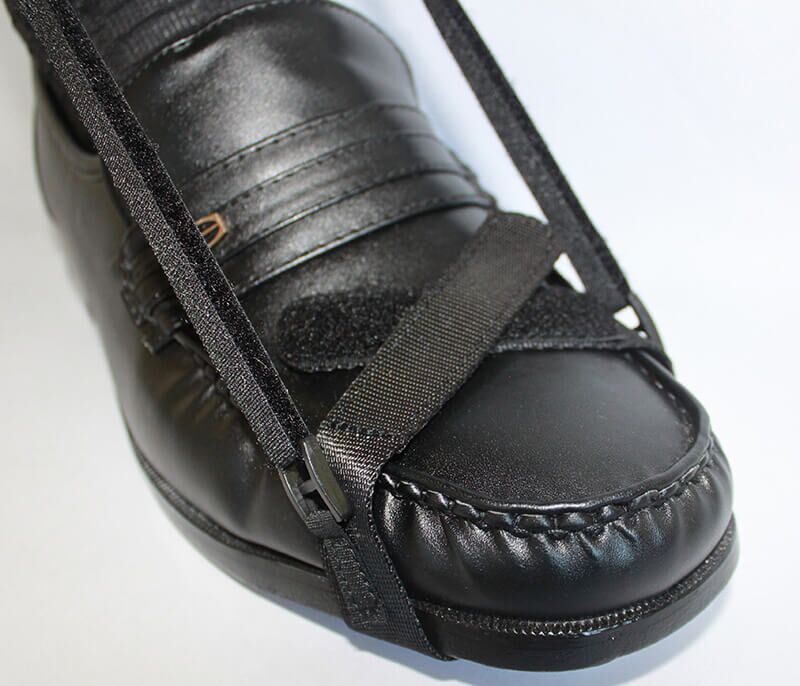Please plan for 3-5 days to deliver your foot brace order. Please get in touch with us to arrange special shipping needs.
Flexible Foot Lift: You may return your item within 30 days of purchase if it is in new condition and shows no visible wear. Please call us with any comments or concerns or arrange plans to return your purchase.
There is no warranty, expressed or implied, that this product will cure any ailment. It was designed to assist in foot drop therapy. No medical claims are made regarding this foot brace.
The Flexible Foot Lift foot support brace utilizes a spring feature to raise the foot and toes to minimize tripping. In contrast to fixed and inflexible foot lifts, which limit ankle mobility, this drop foot brace allows full ankle flexibility and promotes natural movement.
Experience A More Natural Way To Walk!
What does a foot brace do?
Benefits
- Flexible and supports the walking action
- Lightweight and comfortable for all-day wear
- Allows both Dorsi and Plantar flexion; exercises and strengthens affected muscles by spring action
- Adjustable ankle cuff accommodates any swelling
- Custom spring won’t stretch out like elastic
- Use with any shoe or loafer
- No special shoes or inserts are needed
Features
- Quality construction
- Can be used on either foot
- Multiple sizes – Small to X Large
- Two different shoe attachments included: Eyelet Attachment for lace shoes and Foot Strap Attachment for loafers
- One barefoot attachment for use around the house or at night while sleeping (available in black only)
- Two colors – Beige and Black
- Unique spring action straps are easily adjusted to the severity and angle of foot drop
- Designed by a neurologist, Patented and made in the USA
Foot Drop Brace Instructions & FAQ
Cleaning and Maintaining Your Flexible Foot LIft
By following the instructions below, you can extend the life of your Flexible Foot Lift.
- To clean the foam liner, separate it from the hook and loop the attachment on the cuff. Hand wash in mild detergent, pat dry, and let air dry before reattaching.
- The outer cuff can be cleaned with a damp cloth using mild soap. Rinse with a wet towel and let air dry.
- DO NOT PUT INTO CLOTHES DRYER OR DRY CLEAN. The springs should be dried after washing.
- The foot strap can be hand-washed using a mild soap. Rinse and dry before using again.
Notes: Using harsh soaps can discolor the fabrics used. Stretching the springs past 1.5 inches will shorten their life. High heat can melt or deform the plastic parts used in the device.
Click here for printable instructions with diagrams on using the Flexible Foot Lift.
KX2 Flexible Foot Lift FAQ
What is Foot Drop?
Foot drop, sometimes called “drop foot,” is the inability to lift the front part of the foot, causing the toes to drag while walking. People with foot drop may compensate by raising their knees higher than normal or swinging their legs in an arc. Foot drop stems from weakness or paralysis of the muscles that lift the foot and may involve one or both feet.
Foot Drop is Not a Disease
As a symptom of an underlying problem, foot drop is not a disease and can be temporary or permanent.
What Causes Foot Drop?
As a symptom of an underlying problem, foot drop is not a disease and can be temporary or permanent. Causes of foot drop include nerve injury in the leg or back, peripheral neuropathies, and brain or spinal disorders.
Nerve Injury
Commonly, foot drop is caused by an injury to the peroneal nerve or the lumbar nerve roots. Located close to the skin surface, the peroneal nerve wraps from the back of the knee to the front of the shin. The lumbar nerve roots in the back also supply the muscles that lift the foot.
- Peroneal nerve injury
- Pressure injury – prolonged sitting in a cross-legged or squatting position
- Knee injury
- Diabetes
- Hip or knee replacement surgery
- Lumbar nerve root injury:
- Ruptured discs and calcium deposits in nerve openings
- Back surgery
- Inflammation of the nerve roots
Peripheral Neuropathies
Diabetic neuropathy, Charcot Marie Tooth hereditary neuropathies, and other less frequent neuropathies can cause foot drop in both feet.
Brain and Spinal Disorders
Stroke, Multiple Sclerosis (MS), and Cerebral Palsy can damage the central nerves that control foot lift muscles resulting in foot drop along with other leg muscle weakness.
How do KX2 Devices increase mobility?
KX2 devices allow the user to reclaim the simple act of walking and improve their mobility. Using Flexible Foot Lift technology, the KX2 Device can offer increased stability and control of the lower limbs. This aids in preventing “foot drop” caused by muscle weakness, reducing the risk of trips and falls. The advanced engineering and ergonomic design allow users with foot drop to navigate their environment more safely and securely, ultimately providing the necessary elements for improved overall mobility.
Who needs medical mobility devices & equipment?
Medical mobility devices and equipment are crucial to helping those living with disabilities, physical impairments, or restricted mobility manage their day-to-day lives. From children as young as toddlers to the elderly, these tools can help people of any age maintain independence throughout the course of their life. Mobility aids such as wheelchairs, crutches, motorized scooters, stairlifts, and transfer boards can make it possible for people with mobility challenges to go about their daily activities with confidence, free from the stress of not feeling in control of their bodies or environment.
Will a foot brace help with foot pain?
A foot brace can indeed help manage foot pain, depending on the underlying cause of the pain. Foot braces are designed to provide support, stability, and sometimes compression, which can alleviate discomfort in various foot conditions. Here are a few benefits:
- Support and Stabilization: If the foot pain is due to conditions like plantar fasciitis, flat feet, or overpronation, a brace can offer the necessary support to the arch and heel, reducing strain on these areas.
- Alignment Correction: Some braces are designed to correct alignment issues in the foot or ankle, which can be a source of pain. By promoting proper alignment, these braces can reduce stress on the foot.
- Injury Recovery: For foot injuries such as sprains or fractures, a brace can immobilize the foot, allowing it to heal while reducing pain during movement.
- Reduced Pressure on Joints: Conditions like arthritis can cause joint pain in the foot. A brace can help redistribute pressure away from painful joints.
- Improved Circulation: Certain compression braces can enhance blood flow in the foot, which can help reduce pain and swelling, especially in conditions like edema.
However, it’s important to note that a brace is not a cure-all solution. It’s crucial to identify the underlying cause of the foot pain. Consulting with a healthcare provider, such as a podiatrist or orthopedist, is essential to get a proper diagnosis and treatment plan, including using a foot brace and other therapies like physical therapy, medication, or orthotic inserts. Remember, the effectiveness of a brace will largely depend on the specific foot condition and the individual’s needs.
Is it OK to sleep with a foot brace on?
Whether it’s okay to sleep with a brace depends on the type of foot condition you are dealing with and the specific advice of your healthcare provider. In some cases, wearing a brace at night can be beneficial, while it might not be recommended in others. Here are some considerations:
-
Specific Foot Conditions: Doctors sometimes recommend night splints or clear braces to keep the foot in a stretched position overnight for conditions like plantar fasciitis or Achilles tendonitis. This can help alleviate morning pain and stiffness.
-
Type of Brace: The design of the brace matters. Night splints are typically designed to be worn during sleep and are usually more comfortable and less restrictive than braces meant for daytime activity.
-
Comfort and Circulation: It’s important to ensure the brace doesn’t constrict blood flow or cause discomfort, as this can disrupt sleep and cause other complications.
-
Medical Advice: Always follow the guidance of your healthcare provider. They will recommend what’s best for your specific condition, which may or may not include wearing a brace at night.
-
Skin Health: Prolonged wear of braces, especially without adequate ventilation, can lead to skin issues. It’s crucial to monitor for any signs of skin irritation or breakdown.
-
Adjustment Period: Some people may need a period to get used to wearing a brace at night. Starting with a few hours and gradually increasing can help if your doctor advises nighttime use.
While it can benefit certain conditions, sleeping with a brace is not universally recommended. It’s essential to consult with a healthcare professional for personalized advice based on your specific condition and needs.




Caleb Schallert –
I got this device for my mom and she loves it! Great company to work with friendly and very helpful customer service.
Steve Winter –
We love the flexibility and how easy it is to install on different types of shoes. Easily adjustable and works well for AFO foot drop.
Steve –
KX2 does a great job in developing their products. It is a very straight forward design that works extremely well with all different types and sizes of shoes. I like the fact there are also multiple sizes to uniquely fit what is needed. A great product for foot drop.